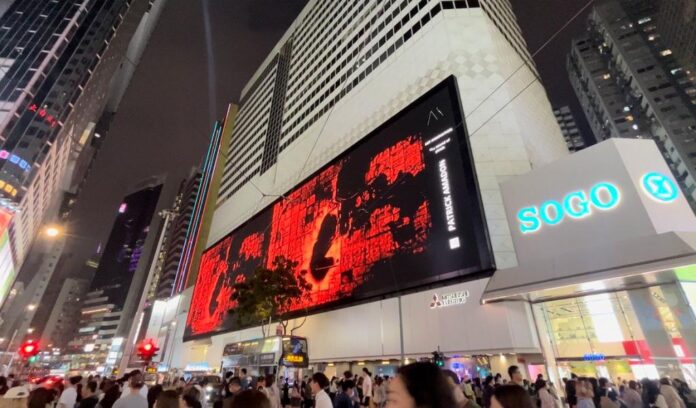A large-scale artwork on show in during the Hong Kong Art Week was censored after the artist revealed that the work is embedded with pro-democracy messages. Pro-Beijing media accused the artwork of being “pro-black rioters.”
Titled , the digital moving image work by Los Angeles-based artist Patrick Amadon was part of the video exhibition “The Sound of Pixels,” organized by the Milan-based Art Innovation Gallery. The screening features works by more than 70 digital artists from around the world on a LED billboard that measures 230 feet by 67 feet and was on view until today, March 23. The screen, the largest of its kind in the Asia Pacific, hangs on the facade of a department store in the shopping district of Causeway Bay.
Amadon’s moving image work depicts a CCTV surveillance camera. After the screening launched, the artist revealed on social media that he has secretly embedded names of the jailed Hong Kong political prisoners who were arrested after the 2019 pro-democracy protests; details about their sentences and alleged crimes flash in the text. The work’s title is part of a popular protest slogan from the 2019 Hong Kong protests: “No rioters, only a tyrannical regime.”
The artist’s message was reported by some local media outlets, and shortly after the state-owned outlet ran a story on Wednesday, March 22, accusing the work of being “pro-black rioters.” The work was removed from the screening schedule by the owners of the department store, Sogo.
“Art week in Hong Kong pretend[s] the Chinese government didn’t crush a democracy and turn Hong Kong in a vassal surveillance state for a week because it’s a convenient location for a good market,” Amadon told Artnet News. “I think it sends the message that money can buy absolution yet again.”

A screen shot of the flashing text from Patrick Amadon’s No Rioters. Names of jailed Hong Kong pro-democracy activists, including that of Benny Tai and Joshua Wong, are listed among the other 47 who were charged for breaching Hong Kong’s new national security law. Image courtesy of the artist.
Amadon confirmed to Artnet News that his work was removed. He said he knew the work could be controversial, but said its total censorship was unexpected. “I knew the protesters’s names, ages, and sentences would be out of bounds. But it is art and a few years ago, this would have been an acceptable and legal expression,” the artist said.
Amadon noted that he did not tell Art Innovation Gallery about the hidden messages in the flashing text. “[I] didn’t want [to force] the responsibility or liability of knowing on them,” he said. “Did I think it would cause this firestorm? No. I wouldn’t have imagined it would agitate as much as it obviously did. Guess it touched a nerve.”
In response to Artnet News’s enquiry, Art Innovation Gallery’s founder and CEO Francesca Boffetti said that the gallery was notified by their mediator that the owners of Sogo decided to take Amadon’s work off of display, and added that the gallery respected Sogo’s decision. “Art Innovation is based in Milan and in Europe, [where] there is freedom of expression. In China, the culture is different from ours,” Boffetti told Artnet News.
Sogo and its owner Lifestyle International did not respond to Artnet News’s requests for comments.
The removal of came after Tuesday’s cancellation of the release of a British slash horror movie . The film, which was approved by the local film censorship board, was originally scheduled for a theatrical release in Hong Kong today, March 23. But the distributor backpedaled, announcing the sudden cancellation and citing “technical reasons,” adding that they were told by cinemas that the film could not be shown. The incident sparked speculations as the image of the cartoon figure had been previously linked to the Chinese President Xi Jinping, and Winnie the Pooh has been banned in China.
Both incidents happened as Hong Kong celebrates its post-pandemic return to the international stage amid the opening of Art Basel Hong Kong alongside various art events at its cultural institutions. The international art world has returned, but the city is noticeably different. There were also reports of Hong Kong’s increasing self-censorship following the implementation of the sweeping national security law in 2020.

























